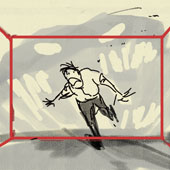As the film language evolved, a lot of experimentation began with the way the camera was placed or rather how a shot was presented. To increase the interest and to convey the right mood in the scene, a lot of conventional camera moves have been derived. They are as following:
1. Tilt:
Moving the camera up or down while keeping its horizontal axis constant. Similar to when you Nod your head up and down - this is tilting.

2. Pan:
Moving the camera to one side or another, keeping its pivot at a fix point. Look to your left, then look to your right - that's panning.

3. Zoom:
Zooming is one camera move that most filmmakers are familiar with. Technically it involves changing the focal length of the lens to make the subject appear closer or further away in the frame. Zooming is one of the most frequently used camera moves and one of the most overused. This action of zoom can be used to direct viewer’s attention to some specific part in the scene. Like zooming in and zooming out are more often used as revealing tools.
Conventional symbols used to show zoom in or zoom out in a storyboard in above figure.

4. Dolly:
If the camera moves towards the subject or away from it, it’s called as a dolly. The name comes from the old "dolly tracks" that used to be laid down for the heavy camera to move along.

5. Truck:
Trucking is similar to dolling but the motion of the camera is left to right. It means physically moving the camera from left to right or vice versa but, keeping the perpendicular relationship intact. Not to confuse it with pan, in which the camera remains firm on its axis only its lens turns from left to right.

For detail information kindly refer to the video:

